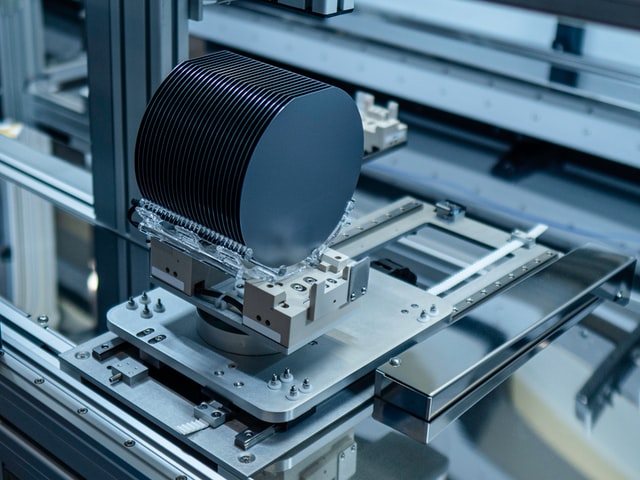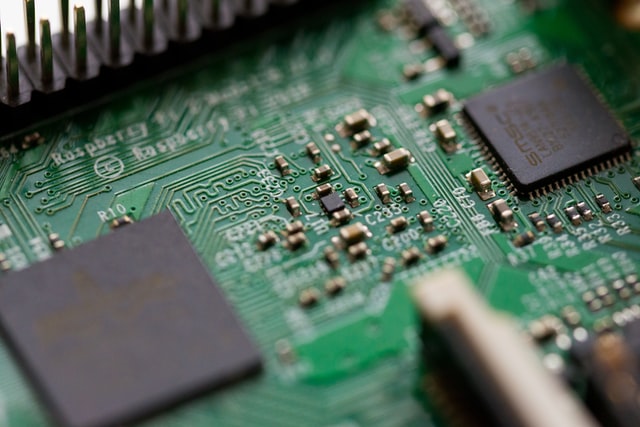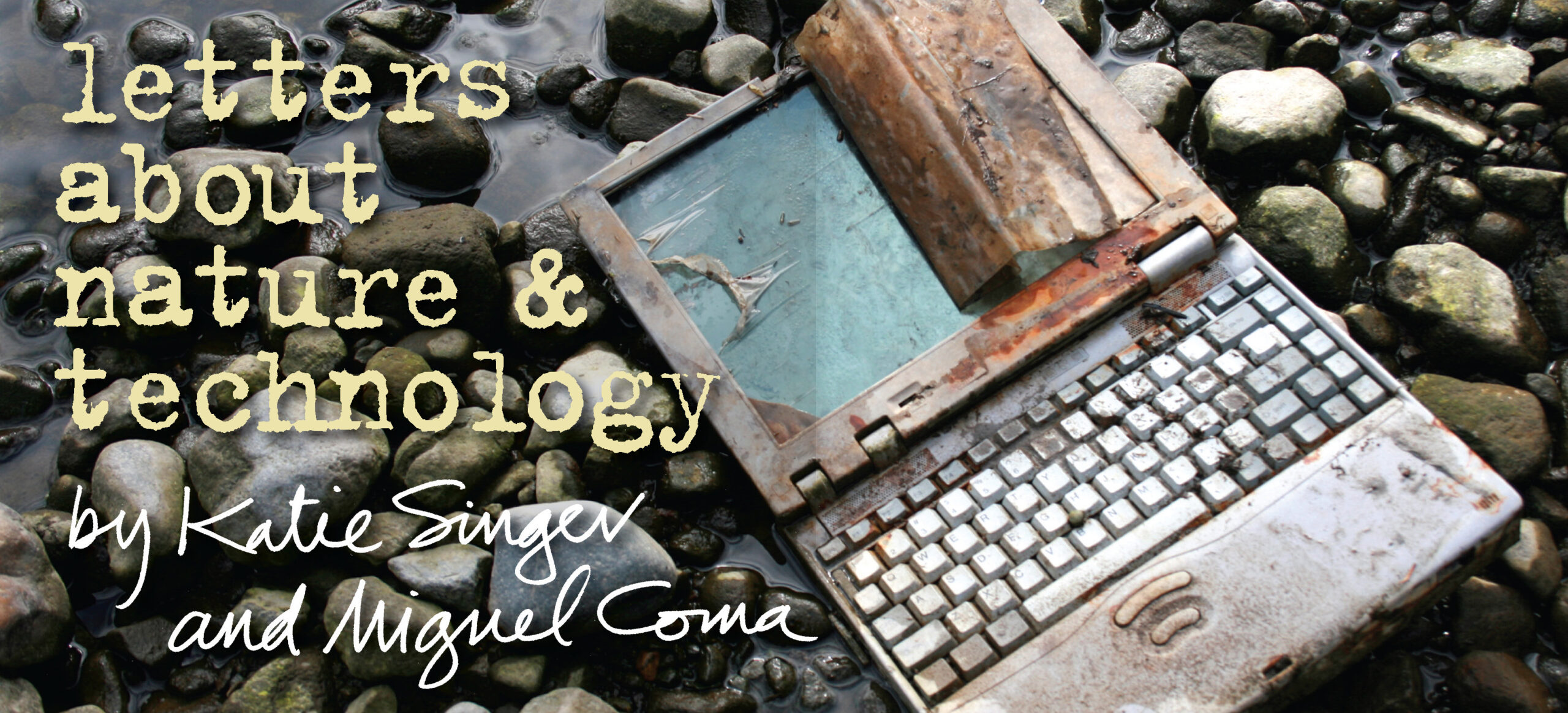Writing from the Internet
an article about nature and technology
by Katie Singer

One of these biodegrades.
Photo credit: Mark Stebnicki and Kari Shea
When I acknowledge the land on which I live and write—as Indigenous People have taught me to do—I feel grateful to that ecosystem. I feel included in it. And so, I say thanks to the land called Northern New Mexico, which has sustained me for thirty years. I thank my parents and grandparents for giving me life, and the land called New York City, where I was born.
Today, I write from the Internet; and so, I thank it for allowing me to share my observations.
The Internet does not have a soul or a spirit. It is not a living creature, not a home or a neighborhood or a country. It is not water, land, metal, air or fire—and yet we use each of these things to manufacture and operate and discard the Internet’s parts. These parts do not absorb carbon dioxide, like a tree, or biodegrade (like living creatures do) when they die.
The Internet provides machine-to-machine communication. It is the largest thing that humanity has built. Its electricity use, fossil fuels, extracted and smelted ores, greenhouse gas emissions, use of chemicals, its toxic waste, worker hazards, fire hazards, degradation of wildlife habitats, impacts to social structures and local authority over environmental and public health policies (its impacts to democracy) are proportionate to its size—and yet most of us users do not see these impacts.
Could we make the Internet’s workings and impacts visible?
Behind the screen, every computer has transistors that process and store data, provide memory and apps. A smartphone uses transistors for GPS, low power microprocessors, sensors, transmitters and receivers (for cellular, Wi-Fi and Bluetooth signals) and noise filtering microphones. Transistors are made from silicon, an element not found in nature in pure form. Manufacturing silicon typically requires pure quartz gravel; a carbon (such as petroleum coke, a byproduct of the Tar Sands, or Blue Gem coal, like that mined in Columbia); and hard, dense, moist wood (like that found in the Amazon rainforest). These three things are transported to a smelter that operates at 3000 degrees Fahrenheit (1649 degrees Celsius) for six or seven years at a time. [1] Because interrupting delivery of electricity to a smelter can blow it up. it cannot be powered by solar or industrial wind facilities, which provide intermittent power. Smelters are powered by coal, nuclear and/or hydro power.

A silicon wafer is one of the most highly refined artifacts ever created by humans. [2] Photo credit: Maxence Pira

Copper traces serve as conductors for a circuit board’s signals. After the construction sector, the electronics industry is the world’s largest consumer of copper. [3] Photo credit: Chris Ried
Young people, typically from rural areas, often aiming to send money home to their families, swipe circuit boards in Chinese factories with solvents like n-hexane. N-hexane causes leukemia and neuro-muscular diseases. [4] Copper, which serves as conductors for the circuit board’s signals, is usually mined in Chile. For every kilogram of copper mined, at least 210 kilograms of waste are generated. [5]
Coltan and cobalt, for mobile devices’ batteries, are mined in the Democratic Republic of Congo. More people have been murdered over coltan than any other single event since World War II. [6] Lithium, also for batteries, takes water from communities and farmers. [7] Discarded lithium batteries can contaminate water supplies. [8]
Computers’ raw materials and manufactured parts get transported between continents on container ships powered by dirty bunker fuel that pollutes the oceans. [9] They’re transported on airplanes and trucks and trains (think of the energy and extractions embodied in each of these great vehicles) that need airports, highways and railroads. This is big business. One smartphone has more than 1000 substances, each with its own energy-intensive, toxic waste-emitting supply chain. [10] Looking at a laptop’s cradle-to-grave energy use, 81% will be consumed during design, mining, smelting, shipping of raw materials, manufacturing of chemicals and assembly—before the end-user turns the laptop on for the first time. [11]
The Internet is not sustainable. It depends on ores and fuels that took billions of years to form. Devices become obsolete within a few years. New software that’s incompatible with “old” hardware and can lead consumers to buy new computers. Most electronic parts are not replaceable or recycled. At the end of their usable life, computers and batteries should be treated as hazardous waste.
Here’s another issue: our world is now nearly saturated in man-made electromagnetic radiation (EMR) used by mobile devices and access networks to transmit and receive information, called data. This EMR is not contained in wires. No agency monitors or limits EMR-exposure’s impacts on sperm, pregnant women, babies, children, wildlife habitats or trees. No agency monitors or limits any living creature’s combined or cumulative EMR-exposure. [12, 13]
The biosphere and the techno-sphere
I’m a writer, nourished by nearness to other living creatures, by nutrient-dense food and clean water, by a home that keeps cool in the summer and warm in the winter, by cycles of work and rest. My computer and the Internet are tools that help me research, write and publish. They do not need rest.
I live on Earth, a physical place, a web of life, a biosphere that provides water, nutrient-dense soil and food.
I write from the Internet, a techno-sphere, created by a corporate, global super-factory that makes and connects and discards machines that generate toxic waste. The Internet is everywhere. It’s in our electronics, cellular antennas and routers and data servers. Its cables are buried around our homes and schools and businesses and hung on utility poles. The air surrounding us holds its data. The Internet operates now past the Earth’s atmosphere and the heliosphere (a shield that protects planets from interstellar radiation). The Internet has no boundaries, and it grows.
Limits to electronic growth
Aware of (some of) the environmental consequences of using this computer, I struggle for peace between my ears. I want to reduce my impacts. I think: to strengthen the biosphere that sustains us, to reduce the extractions, toxic waste, greenhouse gas emissions and worker hazards that ravage our planet, we Internet users will need to make dramatic changes. [14]
Will we limit deployment of new access networks like 5G (fifth generation of mobile access networks) to private networks? [15] Will we create standards that require manufacturers to verify worker and environmental protections from every product’s cradle to its grave? Could we require modular electronics with replaceable parts? Could we enforce policies that require professional engineers to certify the safety of telecom infrastructure before it goes live?
Will we limit the number of hours anyone can stream videos? Should we block every person’s Internet access until they can describe the supply chain of at least one of its substances? Do we teach children to forage or grow at least three kinds of food—and to compost—before they use an electronic device? Do we teach them to read, write and do math on paper before they use electronics? [16]
Do we provide all people on Earth sufficient nutrient-dense food, clean water and toilets before we expand the Internet?
How can we respect the Earth and continue to use the Internet?
REFERENCES
- www.OurWeb.tech/letter-12/
- Schwarzburger, Heiko, “The trouble with silicon,” PV Magazine, 9.15.10.
- https://mineralsusgs.gov.minerals/pubs/commodity/copper/
- Heather White and Lynn Zhang, “Complicit,” 2019.
- Goonan, Thomas G., “Flows of selected materials associated with world copper melting,” U.S. Geological Survey, Open File Report, 2004-1395.
- Eichstaedt, Peter, Consuming the Congo: War and Conflict Minerals in the World’s Deadliest Place, Lawrence Hill Books, 2011.
- Katwala, Amit, “The spiraling environmental cost of our lithium battery addiction,” 8.5.18; https://www.wired.co.uk/article/lithium-batteries-environment-impact.
- Choi, Hye-Bin, et al., “The impact of anthropogenic inputs on lithium content in river and tap water,” Nature Communications, 2019.
- Allan Sekula and Noel Burch, “The Forgotten Space,” 2012.
- Needhidasan, S., et al., “Electronic waste–an emerging threat to the environment of urban India,” J. Environ Health Sci. Eng., Jan. 20, 2014; http://www.ncbi.nlm.nih.gov/pmc/articles/PMC3908467.
- https://spectrum.ieee.org/energy/environment/your-phone-costs-energyeven-before-you-turn-it-on
- Singer, Katie, An Electronic Silent Spring, SteinerBooks, 2014.
- www.saferemr.com
- In 1989, when the USSR broke up and Cuba lost its oil supply, overnight, Cubans traded their cars for bicycles; turned parking lots into farms, and shared their available electronics with neighbors so that the country could survive. Could this serve as an example of a possible response to the techno-sphere’s damaging, unsustainable growth? Faith Morgan, “The Power of Community,” 2006.
- www.OurWeb.tech/letter-4/
- See Criss Rowan’s work at www.zonein.ca.
Katie Singer writes about the energy, extractions, toxic waste and greenhouse gases involved in manufacturing computers, telecom infrastructure, electric vehicles and other electronic technologies. She believes that if she’s not aware that she’s part of the problem, then she can’t be part of the solution. She dreams that every smartphone user learns about the supply chain of one substance (of 1000+) in a smartphone. Her most recent book is An Electronic Silent Spring. She currently writes about nature, democracy and technology for Meer.com. Visit www.OurWeb.tech and www.ElectronicSilentSpring.com.
This article was originally published by Meer.com.
